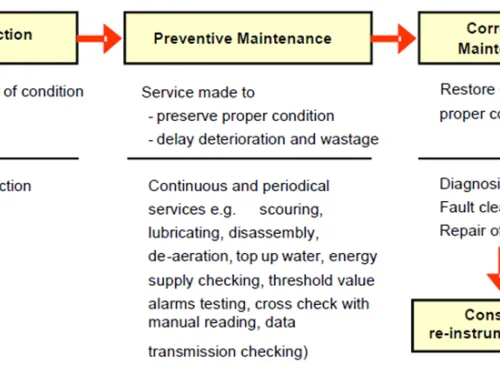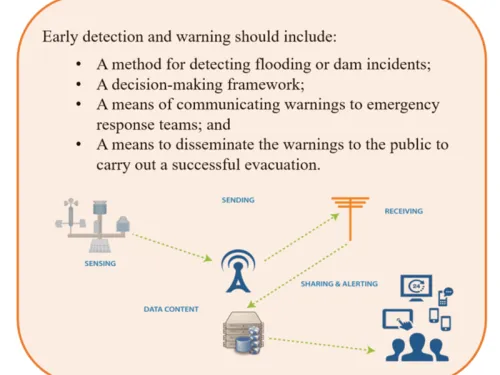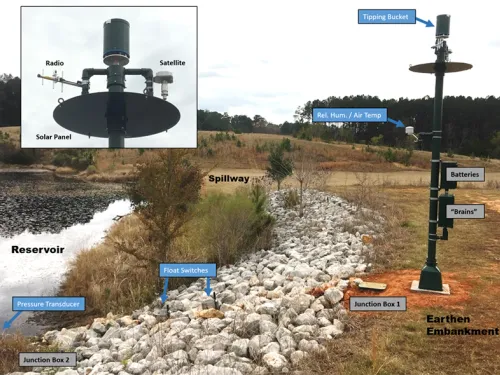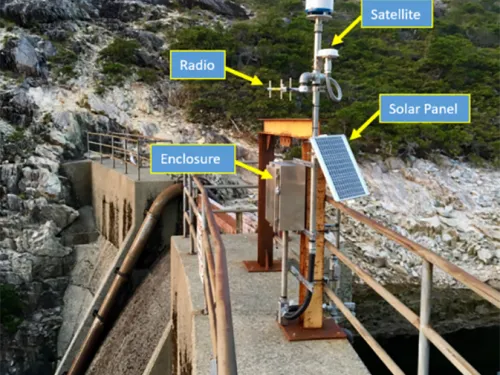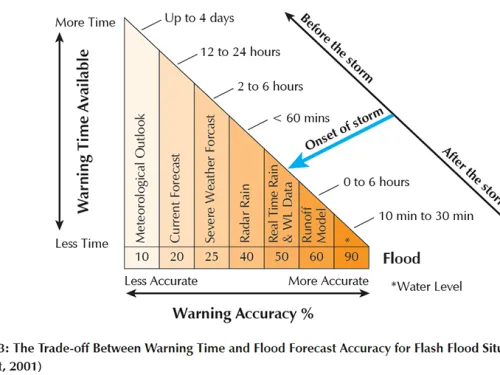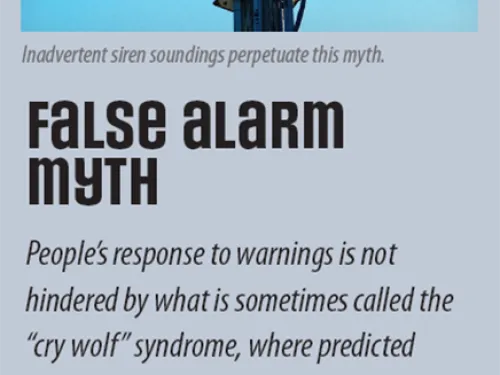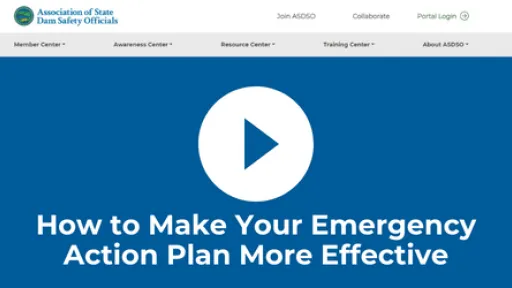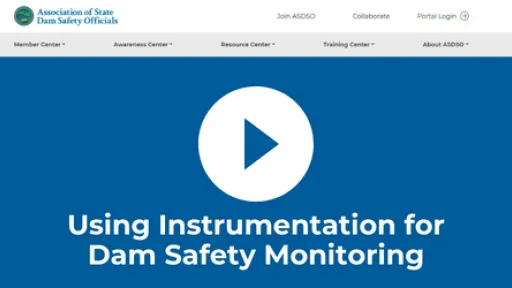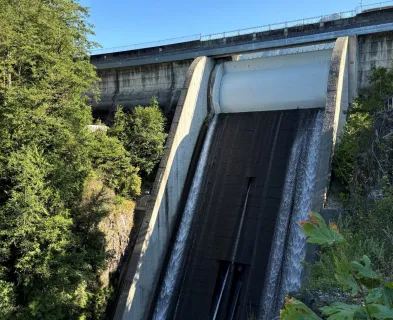Early Warning Systems can provide real-time information on the health of a dam, conditions during incidents, and advanced warning to evacuate ahead of dam failure flooding.
What is an Early Warning System?
Most large dams or dams with high- or significant-hazard potential have at least some instrumentation to monitor dam performance and changes in behavior. Traditionally, dam instrumentation has required a person on-site to make readings and acquire data. Advances in technology and affordability now allow more efficient and effective fully automated collection and dissemination of monitoring data for dams of any size [1].
An Early Warning System (EWS) is an Automated Data-Acquisition System equipped to transmit and process data to include early warning notification features, and programmed to operate without the need of human intervention. An EWS may include various types of sensors, including reservoir/tailwater level monitoring, stream gauges, and weather measurements, however a successful EWS program encompasses much more than just instrumentation and offers numerous potential benefits for a dam/levee safety program.
Benefits of Early Warning
Emergency warning information is the single most important factor in getting people to take the best protective action in an emergency [2]. Remarkable gains in the prediction of pending natural disasters such as hurricanes, tsunamis, and tornados allow for advanced warning that undoubtedly saves lives across the world each year [3]. Weather prediction models continue to improve over time, providing better data and more accurate forecasts for decision makers and first responders. As it relates to dam and levee safety emergencies, timely warning and rapid public response have proven to be critical to reducing life loss. EWS allow owners and emergency response teams to provide advanced warning prior to flooding or to identify incidents that are developing at dams and levees. In addition, an EWS enables proactive steps to be taken during the development stage of a potential failure which may provide additional time to take action to reduce the probability of imminent failure.
Analyses and simulations of historic dam failures show that advanced warning time and prior evacuation before failure can have a fundamental influence on decreasing fatality rates for population at risk (PAR) located within inundation zones [4, 5, 6]. Examples of cases with limited, ineffective or no warning (Austin Dam, Canyon Lake, Malpasset Dam, South Fork Dam, Vajont Dam) can be compared with cases that demonstrate more adequate warning (Baldwin Hills, Castlewood Canyon, Teton Dam, Edenville Dam) to highlight the importance of warning times and rapid community response during dam failures.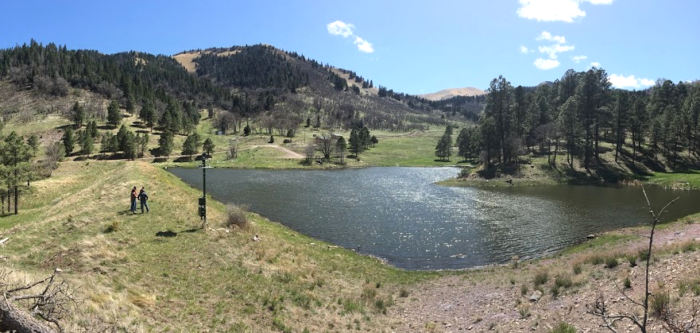
The detection of abnormal, hazardous and/or threatening conditions is the first step in issuing a more timely and effective warning. Early detection and evaluation of the conditions that initiate or require emergency response actions are crucial. Procedures for early notification are required to allow all entities involved with the Emergency Action Plan (EAP) implementation to respond appropriately. The key to reducing warning delay time is to quickly observe conditions, whether seismic, meteorological, structural, or other issues that signify a possible incident in progress. For a facility not continuously attended, an EWS can be installed to monitor conditions and promptly notify emergency management authorities of developing conditions [7, 8], and this incident-specific information can be critical to convincing the public that an incident is occurring and evacuation or response is necessary.
Reasons to Install an EWS at a Dam
Early warning of abnormal conditions or a potential dam safety incident is only one of many reasons to include an EWS at a dam. Other reasons include:
- A near real-time and continuous data record (replacing single point manual readings);
- More frequent and event-driven collection of data, capturing performance under varying loading conditions;
- Ability to analyze data remotely through web-based applications;
- Rapid processing and plotting of data, allowing easier and timelier evaluation and analysis;
- Ability to automatically initiate alarms to notify the appropriate staff when critical thresholds are exceeded;
- Better informed resource allocation of labor during regional, large-scale incidents that may impact multiple dams, and to support critical decision making;
- Rapidly changing phenomena can be measured;
- Continuous data even when the dam is inaccessible or limited by weather conditions (flooding, snow, storms, etc.); and
- Increased accuracy, reliability, and consistency through remote diagnostics and reduced human error from manual data inputs.
Risk Reduction and Cost Savings
An EWS can serve as a risk-reduction measure and provide cost savings to dam owners. Dams and levees are part of aging infrastructure that requires maintenance, and over time, rehabilitation and modifications are necessary [9]. Rehabilitation is often an expensive and lengthy process. Design and construction activities can be prioritized by risk analysis, with the most critical public and dam safety rehabilitation aspects addressed first. However, often budget constraints do not allow for the immediate remediation of all intolerable risk at or above guidelines. EWS installations can function as a non-structural risk mitigation measure until the structure can be improved to current standards [10].
Emergency management programs that effectively provide advanced warning of a change in dam behavior or conditions and evacuate the PAR prior to dam failure can lower risk in at least two key ways – by increasing the likelihood of successful intervention given initiation of a failure mode, and often most substantially, by lowering the fatality rates by increasing evacuation time. In certain cases, dam safety regulators may allow for consideration of an EWS during the inflow design flood selection process, thereby reducing spillway design capacity and construction requirements, providing substantial cost savings to dam owners [11]. EWS installations have become much more affordable and reliable during recent years, especially when considering long-term value and reduced labor costs. Maintenance and testing is still required to keep a system up and running effectively, yet cost is likely far less than continuing to have an operator conduct frequent manual readings.
Relationship to Visual Monitoring
An EWS can supplement routine visual inspections, but never replace them. Visual surveillance is one of the most important components of a dam safety program. Thorough visual 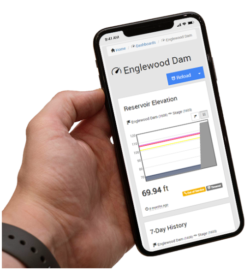 inspection by staff who are knowledgeable about a dam’s vulnerabilities and potential failure modes can provide insight and warning of unexpected performance that may not be captured from with instrumentation readings. The EWS instrumentation often collects data from point measurements so cannot provide a complete picture of a dam’s behavior. For example, an EWS may not necessarily identify the occurrence of seepage at a new location along a section of embankment that is not instrumented. When designing, reviewing, or auditing an EWS, there should be a clear understanding of what potential failure mode components that instrumentation is monitoring for, as well as the components not being monitored through instrumentation. Visual monitoring is the complimentary approach to address this missing monitoring component (as well as an essential practice for general project health). Normally EAP responses should not be initiated prior to visual confirmation.
inspection by staff who are knowledgeable about a dam’s vulnerabilities and potential failure modes can provide insight and warning of unexpected performance that may not be captured from with instrumentation readings. The EWS instrumentation often collects data from point measurements so cannot provide a complete picture of a dam’s behavior. For example, an EWS may not necessarily identify the occurrence of seepage at a new location along a section of embankment that is not instrumented. When designing, reviewing, or auditing an EWS, there should be a clear understanding of what potential failure mode components that instrumentation is monitoring for, as well as the components not being monitored through instrumentation. Visual monitoring is the complimentary approach to address this missing monitoring component (as well as an essential practice for general project health). Normally EAP responses should not be initiated prior to visual confirmation.
Instruments often supply measurements that may evade visual surveillance such as pressures and flow. By providing data that supplements visual surveillance, a clearer understanding of dam performance is possible. An EWS produces this data and a long-term, quantitative record, which may provide insight into time-or load-depended trends in a dam’s performance. The ability to detect a change over time is important because these changes may be indicative of a developing potential failure mode [1].
When can an EWS be useful?
An EWS can be useful for a variety of monitoring needs during the life of a dam, including:
- During construction;
- First reservoir filling;
- Normal operations;
- During times of high releases;
- Abnormal loadings or incident/failure scenarios; and
- Support of legal and research needs [12].
An EWS can be beneficial on both dams and levee systems. The consequences of levee failures can be just as catastrophic as dam failures, so although monitoring levees present additional challenges largely related to their areal extent and intermittent loadings, they can often be monitored effectively [13].
EWS are especially valuable in situations when visual surveillance is not possible, for remote locations with access challenges, or during times when visual inspections are irregular (e.g. nights, weekends, harsh winters, and during storm events when visibility is low). An EWS can be programmed to capture and transmit data more frequently during flood events, as well as record data at regular intervals during normal conditions. Generally, automated instrumentation should receive consideration during new dam construction, major rehabilitations, or structural modifications [14].
The Future of EWS
Improved dam safety programs have helped reduce the number and impact of major dam failures, but work remains. From 2005 to 2019, state dam safety programs reported 296 dam failures. Future dam safety improvements will include non-structural measures, including continued deployment of Early Warning Systems [15]. Aging of existing dams is a universal issue that will become more challenging with time. With society’s growing concern about the safety of structures and increasing populations at risk in inundation zones, it is logical to expect that regulatory agencies will require more automatic monitoring of dams in the future [16].
Additional Best Practices
Top Ten Best Practices for EWS Design and Implementation
- Remember that an effective EWS is not simply a collection of instruments.
- Decide what needs to be measured.
- Keep it as simple as possible, but not simpler.
- Hire a professional.
- Design with telemetry and power supply in mind.
- Design with maintenance, safety, and accessibility in mind.
- Design for robustness and redundancy to make the system highly reliable.
- Make the data useful and intuitive.
- Ensure proper notifications and alarms.
- Take advantage of the latest technology.
References:
(1) Rubertis, K. (2018). Monitoring Dam Performance: Instrumentation and Measurements, American Society of Civil Engineers (ASCE), Manuals and Reports on Engineering Practice No. 135. Task Committee to Revise Guidelines for Dam Instrumentation.
(3) Silver, N. (2012). The Signal and the Noise: Why So Many Predictions Fail-but Some Don't. Penguin Press.
(5) Graham, W.J. (1999). A Procedure for Estimating Loss of Life Caused by Dam Failure (DSO-99-06). United States Department of the Interior, Bureau of Reclamation, Dam Safety Office.
(6) USACE. (2020). HEC-LifeSim Life Loss Estimation. US Army Corps of Engineers, Hydrologic Engineering Center.
(9) ASCE (2017). America’s Infrastructure Report Card. American Society of Civil Engineers. (Updated for 2021)
(11) Colorado Dam Safety Branch. (2020). Guidelines for Hydrologic Hazard Analysis. State of Colorado, Division of Water Resources, Department of Natural Resources, Dam Safety Branch. Section 2.11.
(15) ICOLD. (2020). Challenges and Needs for the Dams in the 21st Century, Bulletin 185. International Commission on Large Dams, Preprint Edition.
(16) ICOLD. (2000). Automated Dam Monitoring Systems: Guidelines and case histories, Bulletin 118. International Commission on Large Dams.
(17) Dunnicliff, J. (1988). Geotechnical Instrumentation for Monitoring Field Performance, John Wiley & Sons, Inc., New York.
(18) ICOLD. (2018). Dam Surveillance Guide, Bulletin 158. International Commission on Large Dams.
(20) Reclamation. (2001). Reclamation’s Design Process of Early Warning Systems for Dam Safety. Bureau of Reclamation, Water Operation and Maintenance Bulletin, p.19-23. David B. Fisher.
(21) BIA. (2014). Safety of Dams Program Handbook. Dam Safety, Security, and Emergency Management, 55 IAM-H. U.S. Department of the Interior, Bureau of Indian Affairs.
This lesson learned summary was peer-reviewed by Bill Johnstone, Spatial Vision Group; Jackie Blumberg, Korey Kadrmas, and Bill McCormick, Colorado DWR; Dan Klein, FERC; Dusty Myers, Eagle Creek Renewable Energy; Alon Dominitz, NY Dam Safety; and Mike Hand, WYOH2OPE.

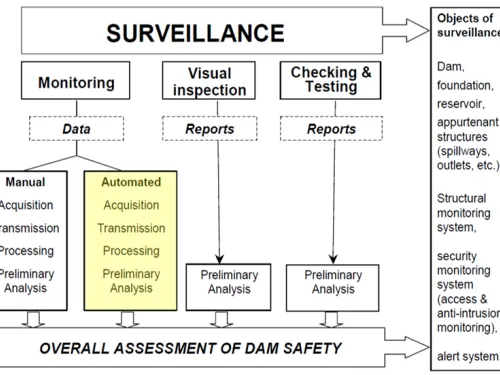
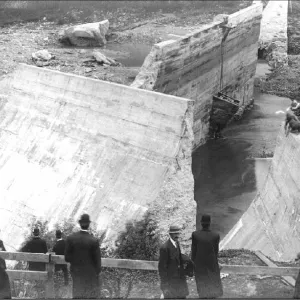
Austin (Bayless) Dam (Pennsylvania, 1911)
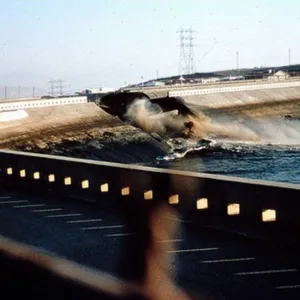
Baldwin Hills Dam (California, 1963)
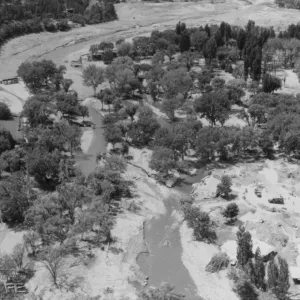
Canyon Lake Dam (South Dakota, 1972)

Castlewood Canyon Dam (Colorado, 1933)

Cleveland Dam (British Columbia, 2020)
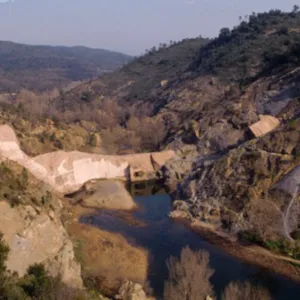
Malpasset Dam (France, 1959)

Swift and Two Medicine Dams (Montana, 1964)

Teton Dam (Idaho, 1976)
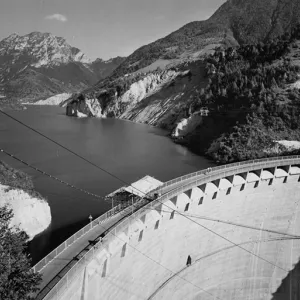
Vajont Dam (Italy, 1963)

Williamsburg Reservoir Dam (Massachusetts, 1874)
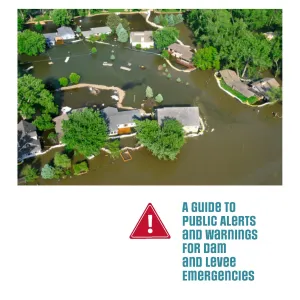
A Guide to Public Alerts and Warnings for Dam and Levee Emergencies
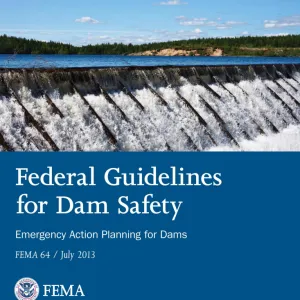
Federal Guidelines for Dam Safety: Emergency Action Planning for Dams
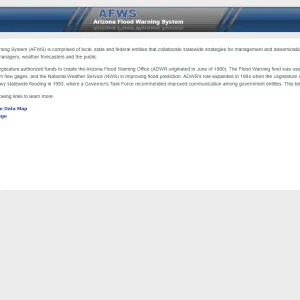
Arizona Flood Warning System (AFWS)
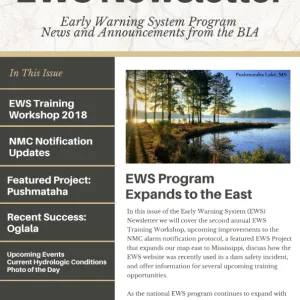
BIA Newsletter - Issue 02

BIA Newsletter - Issue 03
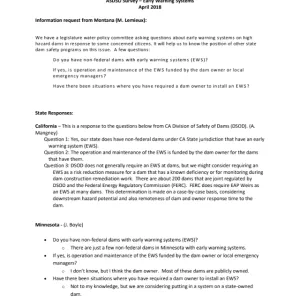
EWS State Survey
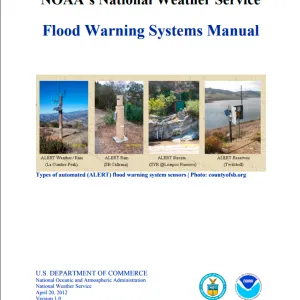
Flood Warning Systems Manual

Harris County Flood Control District (Texas)
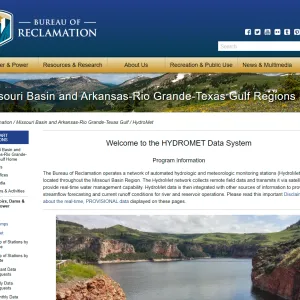

MHDF (Colorado) – Flood Warning Program Website



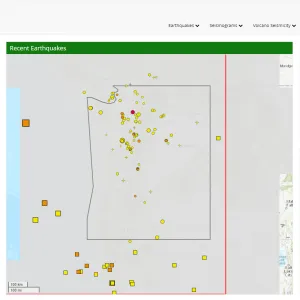
Pacific Northwest Seismic Network
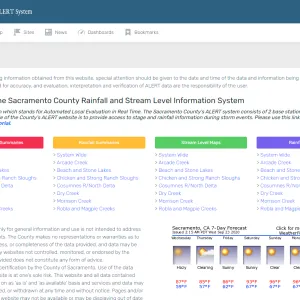
Sacramento County Alert System (California)

U.S. Tsunami Warning System
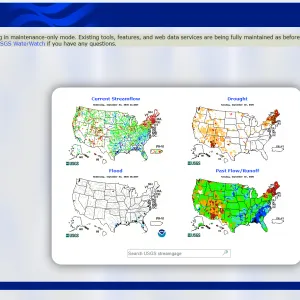
USGS WaterWatch

